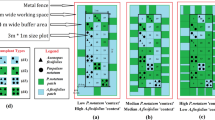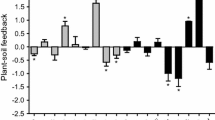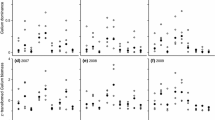Abstract
We examined two ways in which species effects on nitrogen supply rates could influence species competitive interactions and lead to coexistence between species with very different patterns of resource use. First, through differential effects on the rates of resource cycling, species may modify resources in divergent directions to better tolerate neighbors under self-modified conditions (tolerance modification). Second, plant-induced shifts in resource supply could enhance the degree to which species can suppress individuals (suppression modification). We addressed these hypothesized mechanisms in the non-successional moist meadow alpine tundra, which is codominated by Acomastylis rossii, a slow-growing roseaceous forb with high nutrient retention that is associated with slow rates of nitrogen supply, and Deschampsia caespitosa, a graminoid with rapid growth potential that is associated with fast rates of nitrogen (N) supply. Neighbors inhibited Acomastylis transplants (the species with high N retention) less than Deschampsia transplants (the species with rapid potential growth) in both neighborhood types, and hence neighborhood type did not influence species tolerance to neighbors. Likewise, Acomastylis neighborhoods inhibited transplant growth more than Deschampsia neighborhoods regardless of transplant species identity. When N supply rates were enhanced through repeated N additions in the two neighborhood types or in the presence of each species’ litter, the inhibitory effects associated with Acomastylis were offset to a greater degree than those associated with Deschampsia, as predicted by the suppression modification. These effects appeared to be density or size-dependent, with few effects observed at low density. Our results suggest that species effects on supply rates may influence competitive interactions, particularly if these effects are complemented by other sources of temporal or spatial variation such as pulses in resource availability.
Similar content being viewed by others
References
Aerts R. and Chapin F.S. III. 2000. The mineral nutrition of wild plants revisited: a re-evaluation of processes and patterns. Ad-vances in Ecological Research 30: 1-67.
Aerts R. and de Caluwe H. 1997. Nutritional and plant-mediated controls on leaf litter decomposition of Carex species. Ecology 78: 244-260.
Aerts R. 1997. Nitrogen partitioning between resorption and decomposition pathways: a trade-off between nitrogen use effi-ciency and litter decomposability? Oikos 80: 603-606.
Aerts R., Bakker C. and de Caluwe H. 1992. Root turnover as de-terminant of the cycling of C, N, and P in a dry heathland eco-system. Biogeochemistry 15: 175-190.
Bardgett R.D., Mawdsley J.L., Edwards S. 1999. Plant species and nitrogen effects on soil biological properties of temperate upland grasslands. Functional Ecology 13: 650-660.
Bardgett R.D., Streeter T.C., Cole L. 2002. Linkages between soil biota, nitrogen availability, and plant nitrogen uptake in a moun-tain ecosystem in the Scottish Highlands. Applied Soil Ecology 19: 121-134.
Baron J.S, Rueth H.M., Wolfe A.M. 2000. Ecosystem responses to nitrogen deposition in the Colorado Front Range. Ecosystems 3: 352-368.
Berendse F. and Aerts R. 1987. Nitrogen use efficiency: a biologi-cally meaningful definition? Functional Ecology 1: 293-296.
Berendse F. and Elberse W.T. 1990. Competition and nutrient availability in heathland and grassland ecosystems.. pp. 93-116. In: Grace J.B. and Tilman D.(eds), Perspectives on Plant Com-petition. Academic Press, New York, USA.
Berendse F. 1994a. Competition between plant populations at low or high nutrient supplies. Oikos 71: 253-260.
Berendse F. 1994b. Litter decomposability-a neglected compo-nent of plant fitness. Journal of Ecology 82: 187-190.
Berendse F. 1998. Effects of dominant plant species on soils dur-ing succession in nutrient-poor ecosystems. Biogeochemistry 42: 73-88.
Bilbrough C.J., Welker J.M. and Bowman W.D. 2000. Early spring nitrogen uptake by snow-covered plants: A comparison of arctic and alpine plant function under the snowpack. Arctic, Antarctic and Alpine Research 32: 404-411.
Bowman W.D., Steltzer H., Rosenstiel T.N., Cleveland C.C. and Meier C.L. in press. Litter effects of two co-occurring alpine species on plant growth, microbial activity and immobilization of nitrogen. Oikos
Bowman W.D. and Bilbrough C.J. 2001. Influence of a pulsed ni-trogen supply on growth and nitrogen uptake in alpine grami-noids. Plant and Soil 233: 283-290.
Bowman W.D. and Steltzer H. 1998. Positive feedbacks to anthro-pogenic nitrogen deposition in Rocky Mountain alpine tundra. Ambio 27: 514-517.
Bowman W.D. 1992. Inputs and storage of nitrogen in winter snowpack in an alpine ecosystem. Artic and Alpine Research 24: 211-215.
Bouwman W.D., Steltzer H., Rosentiel T.N., Cleveland C.C. and Meier C.I. 2004. Litter effects of two co-occurring alpin species on plant growth, microbial activity and immobilization of nitrogen. Oikos 104: 366-344.
Campbell B.D. and Grime J.P. 1992. An experimental test of plant strategy theory. Ecology 73: 15-29.
Chapin F.S. III. 1980. The mineral nutrition of wild plants. An-nual review of ecology and systematics 11: 233-260.
Chapin F.S., Bloom A.J., Field C.B. 1987. Plant species to mul-tiple environmental factors. BioScience 37: 49-57.
Chesson P. 2000. Mechanisms of maintenance of species diversity. Annual review of Ecology and Systematics 31: 343-367.
Goldberg D.E. and Werner P.A. 1983. Equivalence of competitors in plant communities, a null hypothesis and a field experimental approach. American Journal of Botany 70: 1098-1104.
Goldberg D.E. 1990. Components of resource competition in plant communities,. pp. 27-50. In: Grace J.B. and Tilman D. (eds), Perspectives on Plant Competition. Academic Press, New York, USA.
Goldberg D.E. 1996. Competitive ability: definitions, contingency, and correlated traits. Phil. Trans. R. Soc. London, Series B 351: 1377-1385.
Grace J.B. 1990. On the relationship between plant traits and com-petitive ability,. pp. 51-66. In: Grace J.B. and Tilman D. (eds), Perspectives on Plant Competition. Academic Press, New York, USA.
Grace J.B., Keough L. and Guntenspergen G.R. 1992. Size bias in traditional analyses of substitutive competition experiments. Oecologia 90: 429-434.
Grime J.P. 1977. Evidence for the existence of three primary strat-egies in plants and its relevance to ecological and evolutionary theory. American Naturalist 111: 1169-1194.
Grime J.P., Thompson K., Hunt R., Hodgson J.G. and Cornelissen J.H.C. 1997. Integrated screening validates primary axes of spe-cialisation in plants. Oikos 79: 259-281.
Hedges L.V., Gurevitch J. and Cutris P.S. 1999. The mata-analysis of response ratios in ecology. Ecology 80: 1150-1156.
Hobbie S.E. 1992. Effects of plant species on nutrient cycling. TREE 7: 336-339.
Horner J.D., Gosz J.R. and Cates R.G. 1988. The role of carbon-based plant secondary metabolites in decomposition in terrestrial ecosystems. American Naturalist 132: 869-883.
Howard T.G. 2001. The relationship of total and per-gram rank-ings in competitive effect to the natural abundance of herbaceous perennials. Journal of Ecology 89: 110-117.
Hunt R. and Cornelissen J.H.C. 1997. Components of relative growth rate and their interrelations in 59 temperate plant spe-cies. New Phytologist 135: 395-417.
Huston M.A. and De Angelis D.L. 1994. Competition and coexist-ence: the effects of resource transport and supply rates. Ameri-can Naturalist 144: 954-977.
Inouye R.S. and Tilman D. 1995. Convergence and divergence of old-field vegetation after 11 years of nitrogen addition. Ecology 76: 1872-1887.
Kleb H.R. and Wilson S.D. 1999. Scales of heterogeneity in prai-rie and forest. Canadian Journal of Botany 77: 370-376.
Kochy M. and Wilson S.D. 2000. Competitive effects of shrubs and grasses in prairie. Oikos 91: 385-395.
Lawton J.H. 1994. What do species do in ecosystems? Oikos 71: 367-374.
Lipson D.A., Raab T.K., Schmidt S.K. and Monson R.K. 1999. Variation in the competitive abilities of plants and microbes for specific amino acids. Biology and Fertility of Soils 29: 257-261.
Loreau M. 1998. Ecosystem development explained by competi-tion within and between material cycles. Proceedings of the Royal Society of London, Series B 265: 33-38.
Loreau M. 2001. Microbial diversity, producer-decomposer inter-actions and ecosystem processes: a theoretical model. Proceed-ings of the Royal Society of London, Series B 268: 303-309.
May D.E. and Webber P.J. 1982. Spatial and temporal variation of the vegetation and its productivity, Niwot Ridge,Colorado.. pp. 35-62. In: Halfpenny J.C. (ed.), Ecological studies in the Colo-rado alpine: a festschrift for John W. Marr. University of Colo-rado. Institute of Alpine and Arctic Research, Boulder, Colorado, USA.
Miller A.E. and Bowman W.D. 2002. Variation in nitrogen-15 natural abundance and nitrogen uptake traits among co-occurring alpine species: do species partition by nitrogen form? Oecologia 130: 609-616.
Northup R.R., Dahlgren R.A. and McColl J.G. 1998. Polyphenols as regulators of plant-litter-soil interactions in northern Califor-nia's pygmy forest: a positive feedback? Biogeochemistry 42: 189-220.
Peltzer D.A. and Kochy M. 2001. Competitive effects of grasses and woody plants in mixed-grass prairie. Journal of Ecology 89: 519-527.
Peltzer D.A. and Wilson S.D. 2001. Variation in plant responses to neighbors at local and regional scales. American Naturalist157 (6): 610-625.
Raab T.K., Lipson D.A. and Monson R.K. 1996. Soil amino acid utilization among species of the Cyperaceae: plant and soil pro-cesses. Ecology. 80: 2408-2419.
Steltzer H. and Bowman W.D. 1998. Differential influence of plant species on soil nitrogen transformations within moist meadow alpine tundra. Ecosystems 1: 464-474.
Suding K.N. and Goldberg D.E. 2001. Do disturbances alter com-petitive hierarchies? Mechanisms of change following gap cre-ation. Ecology 82: 2133-2149.
Suding K.N., Goldberg D.E. and Hartman K.M. 2003. Relation-ships among species traits: separating levels of response and identifying linkages to abundance. Ecology 84: 1-16.
Theodose T.A., Jaeger C.H., Bowman W.D. and Schardt J.C. 1996. Uptake and allocation of N-15 in alpine plants: Implications for the importance of competitive ability in predicting community structure in a stressful environment. Oikos 75: 59-66.
Tilman D. and Wedin D. 1991. Plant traits and resource reduction for five grasses growing on a nitrogen gradient. Ecology 72: 685-700.
Tilman D. 1988. Plant strategies and the dynamics and structure of plant communities. Princeton University Press, Princeton, New Jersey, USA.
Tilman D. 1990. Constraints and tradeoffs-toward a predictive theory of competition and succession. Oikos 58: 3-15.
VanVuuren M.M.I., Aerts R., Berendse F. and de Visser W. 1992. Nitrogen mineralization in heathland ecosystems dominated by different plant species. Biogeochemistry 16: 151-166.
Vitousek P.M., Turner D.R., Parton W.J. and Sanford R.L. 1994. Litter decomposition on the Mauna Loa environmental matrix, Hawaii: patterns, mechanisms, and models. Ecology 75: 418-429.
Wardle D., Barker G., Bonner K. and Nicholson K. 1998. Can comparative approaches based on plant ecophysical traits predict the nature of biotic and individual plant species effects in eco-systems? Journal of Ecology 86: 405-420.
Wedin D.A. and Tilman D. 1990. Species effects on nitrogen cy-cling: a test with perennial grasses. Oecologia 84: 433-441.
Williams M.W., Baron J.S., Caine N., Sommerfeld R. and Sanford R. 1996. Nitrogen saturation in the Rocky Mountains. Environ-mental Science and Technology 30: 640-646.
Author information
Authors and Affiliations
Rights and permissions
About this article
Cite this article
Suding, K.N., Larson, J.R., Thorsos, E. et al. Species effects on resource supply rates: do they influence competitive interactions?. Plant Ecology 175, 47–58 (2004). https://doi.org/10.1023/B:VEGE.0000048093.92118.27
Issue Date:
DOI: https://doi.org/10.1023/B:VEGE.0000048093.92118.27




